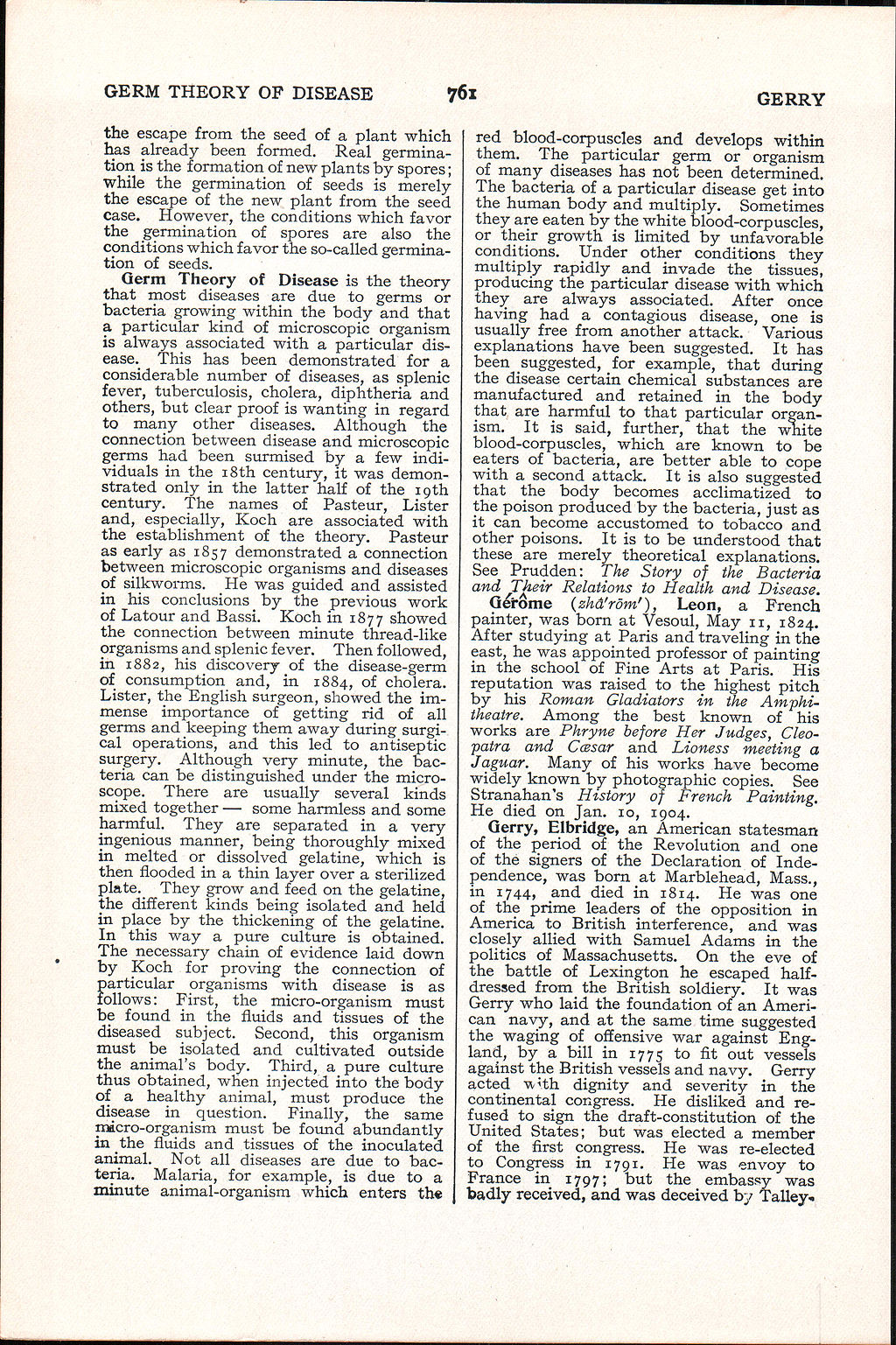Page 761 : GERM THEORY OF DISEASE — GERRY
Individual articles:
the escape from the seed of a plant which has already been formed. Real germination is the formation of new plants by spores; while the germination of seeds is merely the escape of the new plant from the seed case. However, the conditions which favor the germination of spores are also the conditions which favor the so-called germination of seeds.
Germ Theory of Disease is the theory that most diseases are due to germs or bacteria growing within the body and that a particular kind of microscopic organism is always associated with a particular disease. This has been demonstrated for a considerable number of diseases, as splenic fever, tuberculosis, cholera, diphtheria and others, but clear proof is wanting in regard to many other diseases. Although the connection between disease and microscopic germs had been surmised by a few individuals in the 18th century, it was demonstrated only in the latter half of the 19th century. The names of Pasteur, Lister and, especially, Koch are associated with the establishment of the theory. Pasteur as early as 1857 demonstrated a connection between microscopic organisms and diseases of silkworms. He was guided and assisted in his conclusions by the previous work of Latour and Bassi. Koch in 1877 showed the connection between minute thread-like organisms and splenic fever. Then followed, in 1882, his discovery of the disease-germ of consumption and, in 1884, of cholera. Lister, the English surgeon, showed the immense importance of getting rid of all germs and keeping them away during surgical operations, and this led to antiseptic surgery. Although very minute, the bacteria can be distinguished under the microscope. There are usually several kinds mixed together — some harmless and some harmful. They are separated in a very ingenious manner, being thoroughly mixed in melted or dissolved gelatine, which is then flooded in a thin layer over a sterilized plate. They grow and feed on the gelatine, the different kinds being isolated and held in place by the thickening of the gelatine. In this way a pure culture is obtained. The necessary chain of evidence laid down by Koch for proving the connection of particular organisms with disease is as follows: First, the micro-organism must be found in the fluids and tissues of the diseased subject. Second, this organism must be isolated and cultivated outside the animal’s body. Third, a pure culture thus obtained, when injected into the body of a healthy animal, must produce the disease in question. Finally, the same micro-organism must be found abundantly in the fluids and tissues of the inoculated animal. Not all diseases are due to bacteria. Malaria, for example, is due to a minute animal-organism which enters the red blood-corpuscles and develops within them. The particular germ or organism of many diseases has not been determined. The bacteria of a particular disease get into the human body and multiply. Sometimes they are eaten by the white blood-corpuscles, or their growth is limited by unfavorable conditions. Under other conditions they multiply rapidly and invade the tissues, producing the particular disease with which they are always associated. After once having had a contagious disease, one is usually free from another attack. Various explanations have been suggested. It has been suggested, for example, that during the disease certain chemical substances are manufactured and retained in the body that are harmful to that particular organism. It is said, further, that the white blood-corpuscles, which are known to be eaters of bacteria, are better able to cope with a second attack. It is also suggested that the body becomes acclimatized to the poison produced by the bacteria, just as it can become accustomed to tobacco and other poisons. It is to be understood that these are merely theoretical explanations. See Prudden: The Story of the Bacteria and Their Relations to Health and Disease.
Gérôme (zhā́′rōm′), Leon, a French painter, was born at Vesoul, May 11, 1824. After studying at Paris and traveling in the east, he was appointed professor of painting in the school of Fine Arts at Paris. His reputation was raised to the highest pitch by his Roman Gladiators in the Amphitheatre. Among the best known of his works are Phryne before Her Judges, Cleopatra and Cæsar and Lioness meeting a Jaguar. Many of his works have become widely known by photographic copies. See Stranahan’s History of French Painting. He died on Jan. 10, 1904.
Gerry, Elbridge, an American statesman of the period of the Revolution and one of the signers of the Declaration of Independence, was born at Marblehead, Mass., in 1744, and died in 1814. He was one of the prime leaders of the opposition in America to British interference, and was closely allied with Samuel Adams in the politics of Massachusetts. On the eve of the battle of Lexington he escaped half-dressed from the British soldiery. It was Gerry who laid the foundation of an American navy, and at the same time suggested the waging of offensive war against England, by a bill in 1775 to fit out vessels against the British vessels and navy. Gerry acted with dignity and severity in the continental congress. He disliked and refused to sign the draft-constitution of the United States; but was elected a member of the first congress. He was re-elected to Congress in 1791. He was envoy to France in 1797; but the embassy was badly received, and was deceived by Talley-
